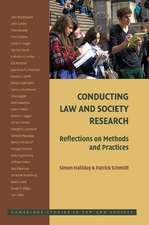Law Mart – Justice, Access, and For–Profit Law Schools: Anthropology of Policy
Autor Riaz Tejanien Limba Engleză Paperback – 17 iul 2017
| Toate formatele și edițiile | Preț | Express |
|---|---|---|
| Paperback (1) | 213.59 lei 6-8 săpt. | |
| MK – Stanford University Press – 17 iul 2017 | 213.59 lei 6-8 săpt. | |
| Hardback (1) | 645.98 lei 6-8 săpt. | |
| MK – Stanford University Press – 17 iul 2017 | 645.98 lei 6-8 săpt. |
Din seria Anthropology of Policy
-
 Preț: 194.45 lei
Preț: 194.45 lei -
 Preț: 194.70 lei
Preț: 194.70 lei -
 Preț: 157.29 lei
Preț: 157.29 lei -
 Preț: 171.47 lei
Preț: 171.47 lei -
 Preț: 207.62 lei
Preț: 207.62 lei -
 Preț: 194.70 lei
Preț: 194.70 lei -
 Preț: 159.17 lei
Preț: 159.17 lei -
 Preț: 240.27 lei
Preț: 240.27 lei -
 Preț: 237.81 lei
Preț: 237.81 lei - 19%
 Preț: 441.79 lei
Preț: 441.79 lei -
 Preț: 483.81 lei
Preț: 483.81 lei
Preț: 213.59 lei
Nou
40.88€ • 44.42$ • 34.36£
Carte tipărită la comandă
Livrare economică 21 aprilie-05 mai
Specificații
ISBN-10: 1503603016
Pagini: 288
Dimensiuni: 152 x 200 x 20 mm
Greutate: 0.41 kg
Editura: MK – Stanford University Press
Seria Anthropology of Policy
Cuprins
Chapter 1 presents the recruitment and training practices that fill the new institution with flesh and blood people. This chapter discusses New Delta School of Law's practices of recruitment of faculty and enrollment of students¿its techniques for finding the human resources making up its organization. Through the use of various techniques, the school and its parent company generated and maintained managed precarity¿a condition whereby teachers and students remain within its purview as employees and clients out of felt necessity more than elective choice. Chapter 1 argues that the operationalization of professional diversity through increased "access" to legal education permitted NDSL to forestall market discipline at a time when many expressed faith in the winnowing function of a legal education free market.
Chapter 2 gives readers a window onto the corporate "culture" of the proprietary law school. There, it argues that the unique law school culture of NDSL served to hold back community reflection on the moral hazard of for-profit legal education. Through structured repetition and reflection, faculty and staff were taught to embrace the ideology of access rather than dwell on their underlying business model¿one that generated millions of dollars annually in "subprime" student debt and transformed them into off-site investor returns.
Chapter 3 describes the feverish growth of the school in the years following onset of the Great Recession. This sudden growth, leading to logistical problems inadequately prepared for, had immediate effects on the 450 new students brought in as first years in 2011. Nevertheless, as this chapter argues, difficulty meeting investor obligations¿rather than any great concern for logistical or pedagogical limitations¿would quickly impose a limit to this large burst of entrepreneurial expansion.
Chapter 4 argues that Legal Education 2.0's emergence had less to do with substantive improvements for law student learning than with pacifying investor fears about the new "crisis" in legal education. Under new professional realities, fourth-tier law schools had to reinvent themselves or risk dissolution. Law Corp, fearful of the investor call on its capital, ordered each of its three schools to develop a new curriculum. At New Delta, the result was a campaign for integrating curriculum soon labeled "Legal Education 2.0."
Chapter 5 moves from reinvention to survival. It describes in detail how school administration conducted and mediated faculty deliberation and democratic ratification of the revised curriculum proposal. This includes a retelling of the unique manner in which the reforms were ultimately passed and the direct impact this had on governance, academic freedom, and basic feelings of respect and dignity among students and educators in this unique environment. Above all, it suggests, Law Corp officers succeeded in confirming a marketable reform agenda by framing the debate as one between tradition and innovation.
Chapter 6 describes how this fiscal "state of exception" changed the structure of school governance by altering the terms by which employees were retained. That shift, from customary to contractual security of position, situates this story within the larger context of neoliberal governance and legal culture. On one hand, academic employees were asked to expand their duties into business development. In one notable episode, NDSL sent several professors to Botswana to establish ties with the national bar, train judges and attorneys in common law jurisprudence, and develop this as a new income stream. On the other hand, with threats of a "reduction in force" in the air, NDSL revised its faculty employment terms, resulting in a conflict with and ultimate termination of tenured senior professors. Amid this information's rapid spread on social media, students flew into a panic and began requesting letters of recommendation to transfer out in record numbers.
Chapter 7 argues the regulatory frameworks governing schools like New Delta have been greatly shaped by the rhetoric of student access. Accepting school officials' narrative that the main hurdle to professional diversity is becoming a lawyer, the scrutiny of key regulatory actors¿here the Department of Education and the American Bar Association¿has been unable to properly grasp the potential harm for-profit law schools are liable to generate. In other words, these schools may not only produce substantial moral hazard, they may also promote the transmission of moral hazard to a new generation of would-be lawyers often rendered as "officers of the court."
The conclusion recaps the book's main themes to reassert its two core claims. The first, directed at legal audiences, says that differentiation by marketization¿by exposure to the disciplinary power of free markets¿is likely to exacerbate professional inequalities. No longer just a theory, this form of differentiation is indeed already on display at New Delta and its sister schools. Thanks to rollbacks in oversight prompted by both antitrust litigation in the 1990s and regulatory capture in the 2000s, the ABA's relatively hands-off approach to for-profit law programs has allowed them to recruit a diversity of students more freely while offering them a different educational program. As my informants describe, these students enter a local profession that already stigmatizes them for this pedigree.
This chapter introduces Law Mart, an ethnography of for-profit law schools, as a contribution to the anthropology of policy and contemporary legal education crisis and reform debates. It explains the recent historical background to the study in a period of significant "boom and bust" in the law school and legal services sector. The chapter situates this intervention among social studies of legal culture, profession, and education. The introduction then offers the book's two core claims. One, directed at legal audiences, says that differentiation by marketization¿by exposure to the disciplinary power of free markets¿is likely to exacerbate professional inequalities. The second, directed at anthropologists, underscores how the metaphor of the "market" has come to occupy the imagination of so many, reformers included, in American academic law.











